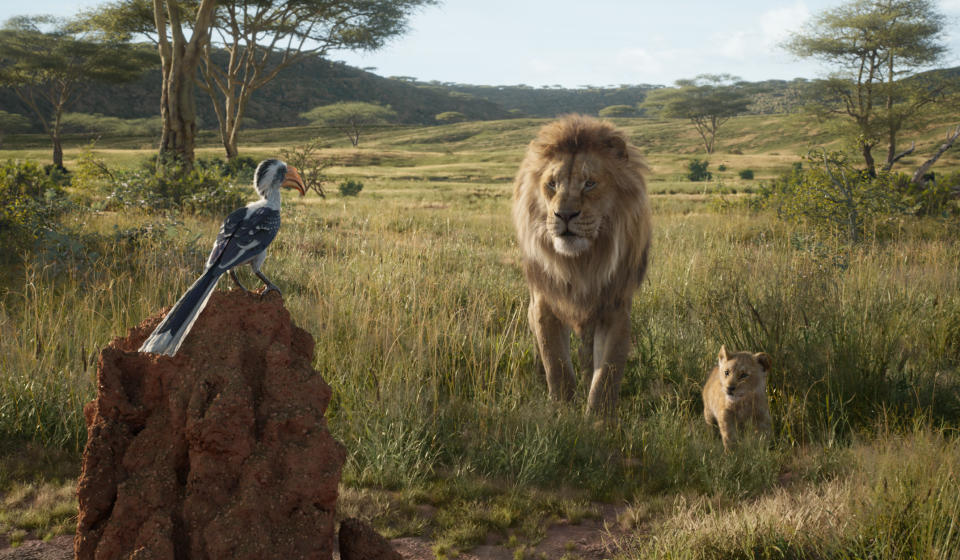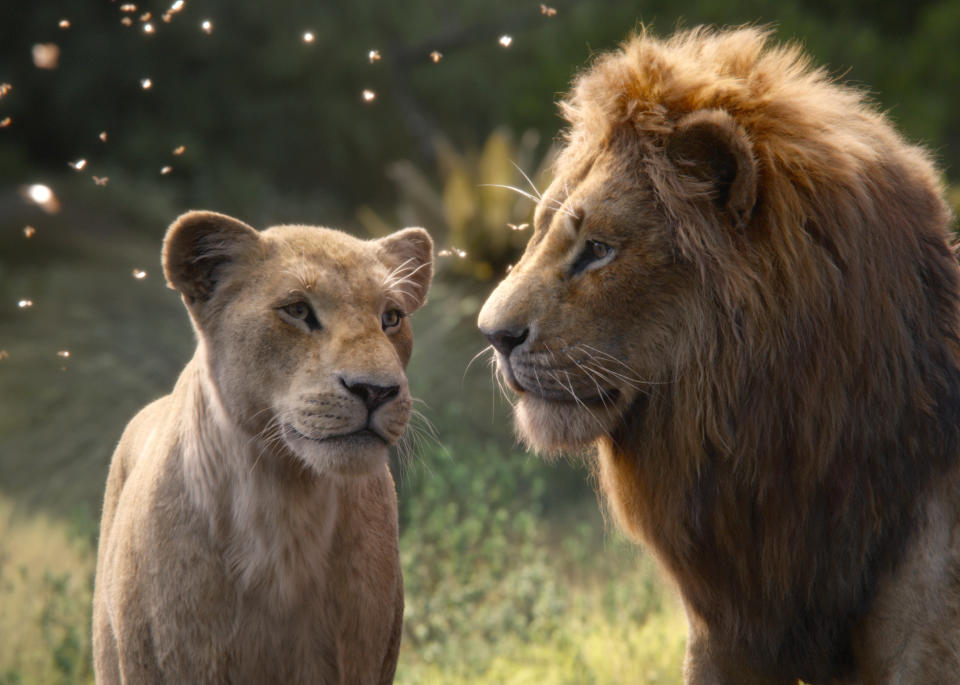'The Lion King': Special effects secrets from Disney's latest billion-dollar blockbuster revealed (exclusive video)
[Editor’s note: A previous version of this article was published on July 31, 2019. The story has been updated with a new video and introduction.]
It’s the circle of life: A classic Walt Disney cartoon becomes a live action blockbuster that kids and their parents fall in love with all over again. That happened with The Jungle Book, Beauty and the Beast and Aladdin, all of which topped the box office charts. The studio’s biggest success story so far is The Lion King, which unleashed a mighty monetary roar in both its 1994 animated incarnation and 2019 remake, which grossed $1.6 billion worldwide. But the new Lion King is unlike its brethren in that it’s not a live action do-over: Instead, director Jon Favreau and the visual effects wizards at MPC Film used a variety of digital techniques to create photorealistic versions of Mufasa, Simba and the rest of the movie’s animal cast. Yahoo Entertainment is premiering an exclusive video that reveals the years-long F/X work that went into making the new film possible. (Watch the video above.)
Because of the mixture of digital technologies that went into the film, Disney has argued all along that this Lion King shouldn’t be classified as an animated movie. In fact, the studio even declined to submit the film for Best Animated Feature consideration, making it eligible in the live action categories instead. Ultimately, the movie received a nomination in the Best Visual Effects category alongside Avengers: Endgame, The Irishman, 1917 and Star Wars: The Rise of Skywalker. And Simba could very easily take that Oscar home: The Lion King was the big winner at the 2020 Visual Effects Society Awards, nabbing three statues overall.
Earlier this year, Yahoo Entertainment spoke with VFX Supervisor, Elliot Newman, who shared how Favreau decided that MPC Film should be the only effects house to work on the movie after previously collaborating with them on his version of The Jungle Book. “Jon felt quite comfortable working with us, and I think he was quite keen to bring the original group back for this one. It would be quite difficult to take a section of this movie and say, ‘Let's have this company do this, and let's have this company do that.’ Doing the whole movie gives you a sense of ownership, and I think it made everyone kind of step up. Everyone just wanted to be better everyday.” Here are some other visual effects secrets we learned about The Lion King.
[Original story continues below.]
Mufasa’s face couldn’t appear in the sky

In one of the biggest departures from the 1994 cartoon, Simba’s ghostly reunion with his father is obscured by serious cloud cover. The original Lion King clearly depicts the dearly departed Mufasa in the night sky, where he promised his son that he and the great kings of the past will always be observing Earthly events. But you have to squint to see the previous lion king’s face in Favreau’s film; his features are just barely visible within the clouds that drift above the African plains, with random lightning flashes functioning as his eyes. “A lot of that had to do with the style of the movie,” Newman explains. “It would have been jarring if Mufasa was suddenly standing up there in the sky, because everything else is so hyper-real. Jon was always saying that he didn’t want it to be a literal thing… and draw the perfect outline of Mufasa in the clouds. He wanted it to have some build-up and drama, so it would feel really epic.”
According to Newman, it was actually more of a challenge for his team to not just slap Mufasa’s face in the sky. “That sequence was quite hard to animate, because it was a really complex cloud and electrical simulations that took many hours to calculate and render. We had to figure out how to give Jon the benefit of working in a kind of sketch mode without him having to use his imagination too much. Because what would happen is that we’d block out a whole scene [as a sketch], and he’d go ‘I can’t really tell, but sure,’ and then we’d present the final render and he’d say, ‘I don’t like it.’ We ended up with a hybrid approach where we [put] layers of cloud simulation on top of an animated space, so we’d have some control over animating it by hand if we needed to modify it. When we presented it to Jon in that format, he could at least see how the clouds were moving and make decisions about the timing.”
Newman remembers Favreau testing out multiple variations of the scene, fully aware of how important it is to Simba’s emotional journey. “We had some sessions with Jon where we were placing compositional elements in real time. We would take Simba and scale him down, or we'd take Mufasa's face and scale him up. Or we’d say, ‘Maybe we need a reverse angle of Simba’s reaction to the cloud here.’ That scene was fluid right up until close to the end, to be honest. We wanted the filmmakers to feel they could engage with us, and not be like, ‘Give us six months, and you’ll see something at the end.’”
Favreau wanted “Can You Feel the Love Tonight” to take place in the afternoon

If you believe Sir Elton John, the early evening hours bring peace and love. Favreau, on the other hand, seems to think that the prime time for romance is when the sun still hangs high in the sky. So when Donald Glover and Beyoncé finally start belting Simba and Nala’s signature song, “Can You Feel the Love Tonight,” it’s more like “Can You Feel the Love in the Late Afternoon.” For the record, Newman is aware of the incongruity between the song’s lyrics and the scene’s lighting. “It’s a question for the filmmakers,” he says with a chuckle. “That was a decision that was made, and we followed that direction. Our job is to visualize the vision of the filmmakers, you know? If that’s what they wanted, then that’s what they wanted.”
Newman can hazard a guess as to why Favreau and his Oscar-nominated director of photography, Caleb Deschanel, chose the daytime over the nighttime, though. “It’s a big moment where you really want to see the characters, and it’s hard to use natural-looking lighting in a nighttime environment, especially when you’re supposed to be shooting [the film] like a documentary,” he notes, adding that he’s never spoken at length with Favreau and Deschanel about that choice. “The mood of the lighting has the right qualities to go with the song, even if the song is at night!”
Rather than focus on the time of day, Newman and his team paid more attention to depicting the body language of two lions in love. “Jon's notion was that you don't have to overdo the expressions of a lion in order to connect emotionally with a lion — you use the visual storytelling to help. We have controls on our facial rig that allow the animators to kind of push certain muscle groups around and move, say, the upper brow into a sad position. But if you’re seeing that on a lion, you’re really pushing it. So we looked a lot at lion behavior for reference: like Nala lifts her head up and licks Simba, and with the combination of the lighting, camerawork and music, it produces an emotion you believe. If we went beyond that, that’s when it would feel overworked for Jon. He was always thinking, ‘Let’s keep this real and not make it too exaggerated.’”
Even with Beyoncé around, Scar is still the star of the show

Sorry Simba: He may have killed your dad and all, but Jeremy Irons’s smokey-voiced Scar continually ranks on or near the top of the list of the all-time best Disney villains. Newman says that The Lion King’s antagonist (voiced in the new film by Chiwetel Ejiofor) was the clear favorite among the VFX team as well. “Whenever we were struggling with a shot, we would always say, ‘It needs more Scar,’” he says, laughing. “He’s such a good-looking character and worked in so many different lighting environments and framings. Every time we dropped him in a shot, the shot improved straightway.”
The animators on the original Lion King took their cue from Irons’s deliciously menacing vocal performance, exaggerating Scar’s features and movements to lend him that extra ounce of villainy. That was an approach that the MPC team tried to pay homage to without upsetting the new film’s emphasis on realism. “The voice of Scar lends itself to something that’s a bit more pushed than the others. Out of all the characters, he’s the least lion-like. His proportions are kind of exaggerated, although we did do a lot of reference and research. There can be huge differences in the proportions between real lions: We’d be looking at pictures, and the skull shapes would be so different, you’d think they’re two different species.” As for Scar’s trademark scar, Newman says that they arrived at the version seen in the finished film via concept art and 3D sculptures in digital clay. “Production designer, James Chinlund, would have done concept art, and we used our digital sculpting tool to show what his face might look like in 3D form. He’s just a pretty cool character.”
Cats versus big cats

In what could potentially be described as a cat fight, Universal released the first trailer for Tom Hooper’s movie version of the Broadway favorite, Cats, the day before The Lion King opened in theaters. [Editor’s Note: Cats opened in theaters on Dec. 25, and bombed with audiences and critics.] The vast difference between The Lion King’s photorealistic big cats and Cats’s more fanciful use of “digital fur technology” was immediately the talk of Twitter. Newman remembers watching the reactions roll in and noting how the divide reflects what contemporary audiences might want from visual effects. “Our job for so many years has been about hiding — if you’ve done your job well, it will be invisible,” he explains. “But with The Lion King, it’s a completely different level: Visual effects are the movie, and Jon is marketing it like that. A movie like Cats is so different, it’s hard to compare them, you know? I’ve strived for so many years to achieve realism, so my visual style would be more like what we’ve done in The Lion King. But that’s just what I prefer doing. It comes down to the individual, really, and what they respond to.”
And Newman says he’s tried to listen to all responses to The Lion King, even those that may not always be positive. “It's really important that everyone listens to that, because we’re making movies for an audience. I like hearing from every side: film critics, the general public, friends and family members. I’ve heard things like, ‘I think this was good, but I kind of prefer the performance of Scar in the original movie.’ Or: ‘The original movie was 30 minutes shorter, and I think it had a better pace.’ Those are all interesting points, and when you’ve been involved with something for so long, you need outside opinions. We’ve definitely all been glued to our Twitter feeds, and biting our nails. Obviously there's people saying, ‘I'm not sure about this realism,’ but at least the one thing they're all saying is, ‘The visuals are amazing.’ That makes me think, ‘I've done my job!’”
The Lion King is streaming on Disney+
Read more from Yahoo Entertainment:

